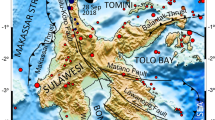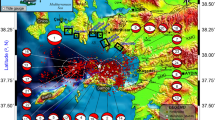Abstract
The December 26, 2004 Sumatra-Andaman earthquake that registered a moment magnitude (M w) of 9.1 was one of the largest earthquakes in the world since 1900. The devastating tsunami that resulted from this earthquake caused more casualties than any previously reported tsunami. The number of fatalities and missing persons in the most seriously affected countries were Indonesia - 167,736, Sri Lanka - 35,322, India - 18,045 and Thailand - 8,212. This paper describes two field visits to assess tsunami effects in Sri Lanka by a combined team of Japanese and Sri Lankan researchers. The first field visit from December 30, 2004 – January 04, 2005 covered the western and southern coasts of Sri Lanka including the cities of Moratuwa, Beruwala, Bentota, Pereliya, Hikkaduwa, Galle, Talpe, Matara, Tangalla and Hambantota. The objectives of the first field visit were to investigate the damage caused by the tsunami and to obtain eyewitness information about wave arrival times. The second field visit from March 10–18, 2005 covered the eastern and southern coasts of Sri Lanka and included Trincomalee, Batticaloa, Arugam Bay, Yala National Park and Kirinda. The objectives of the second visit were mainly to obtain eyewitness information about wave arrival times and inundation data, and to take relevant measurements using GPS instruments.
Access this chapter
Tax calculation will be finalised at checkout
Purchases are for personal use only
Preview
Unable to display preview. Download preview PDF.
Similar content being viewed by others
References
Chapman, C. (2005), The Asian tsunami in Sri Lanka: A personal experience, EOS 86(2), 13–14.
Intergovernmental Oceanographic Commission (1998), Post-tsunami Survey Field Guide, UNESCO Manuals and Guides 37, 62 pp.
Iugg Tsunami Commission (2005), Compiling the trace height of Indian Ocean tsunami, Internat. Un. Geod. Geophy. 8 pp.
Liu, P.L.-F., Lynett, P., Fernando, H., Jaffe, B.E., Fritz, H., Higman, B., Morton, R., Goff, J., and Synolakis, C. (2005), Observations by the International Tsunami Survey Team in Sri Lanka, Science 308(5728), 1595.
Miura, M. and Midorikawa, S. (2006), Extraction of Tsunami inundation area in the eastern part of Sri Lanka due to the 2004 Sumatra earthquake using high-resolution satellite images, Proc. third internat. Conf. Urban Earthq. Engin., March 6–7, Tokyo, Japan, pp. 237–244.
National Disaster Management Center (2005), Summary Report on Tsunami Disaster, Sri Lanka, http://www.lankalibrary.com/news/summary.htm.
Tanioka, Y. and Nishimura, Y. (2005), Field Survey Result in Sri Lanka, The December 26, 2004 Earthquake Tsunami Disaster of Indian Ocean, http://www.drs.dpri.kyoto-u.ac.jp/ sumatra/srilanka2/ (in Japanese).
Tsuji, Y., Namegaya, Y., and Ito, J. (2005), Astronomical tide levels along the coasts of the Indian Ocean, http://www.eri.u-tokyo.ac.jp/namegaya/sumatera/tide.
UN Office of the Special Envoy for Tsunami Recovery (2006), http://www.tsunamispecialenvoy.org/country/humantoll.asp.
USGS (2006), Largest Earthquakes in the World since 1900, http://earthquake.usgs.gov/regional/world/10_largest_world.php.
Wijeyewickrema, A.C., Inoue, S., and Sekiguchi, T. (2005), Tsunami damage in Sri Lanka due to the Sumatra earthquake of December 26, 2004–Preliminary reconnaissance, Proc. Second Internat. Conf. Urban Earthq. Engin., March 7–8, Tokyo, Japan, pp. 181–191.
Wijeyewickrema, A.C., Inoue, S., Matsumoto, H., Miura, H., Gunaratna, P., Madurapperuma, M., and Sekiguchi, T. (2006), Report of two field visits to assess tsunami damage in Sri Lanka due to the Sumatra-Andaman earthquake of December 26, 2004, Proc. Third Internat. Conf. Urban Earthq. Engin., March 6–7, Tokyo, Japan, pp. 219–229.
Author information
Authors and Affiliations
Editor information
Editors and Affiliations
Rights and permissions
Copyright information
© 2007 Birkhäuser Verlag, Basel
About this paper
Cite this paper
Inoue, S. et al. (2007). Field Survey of Tsunami Effects in Sri Lanka due to the Sumatra-Andaman Earthquake of December 26, 2004. In: Satake, K., Okal, E.A., Borrero, J.C. (eds) Tsunami and Its Hazards in the Indian and Pacific Oceans. Pageoph Topical Volumes. Birkhäuser Basel. https://doi.org/10.1007/978-3-7643-8364-0_7
Download citation
DOI: https://doi.org/10.1007/978-3-7643-8364-0_7
Received:
Accepted:
Published:
Publisher Name: Birkhäuser Basel
Print ISBN: 978-3-7643-8363-3
Online ISBN: 978-3-7643-8364-0
eBook Packages: Earth and Environmental ScienceEarth and Environmental Science (R0)




